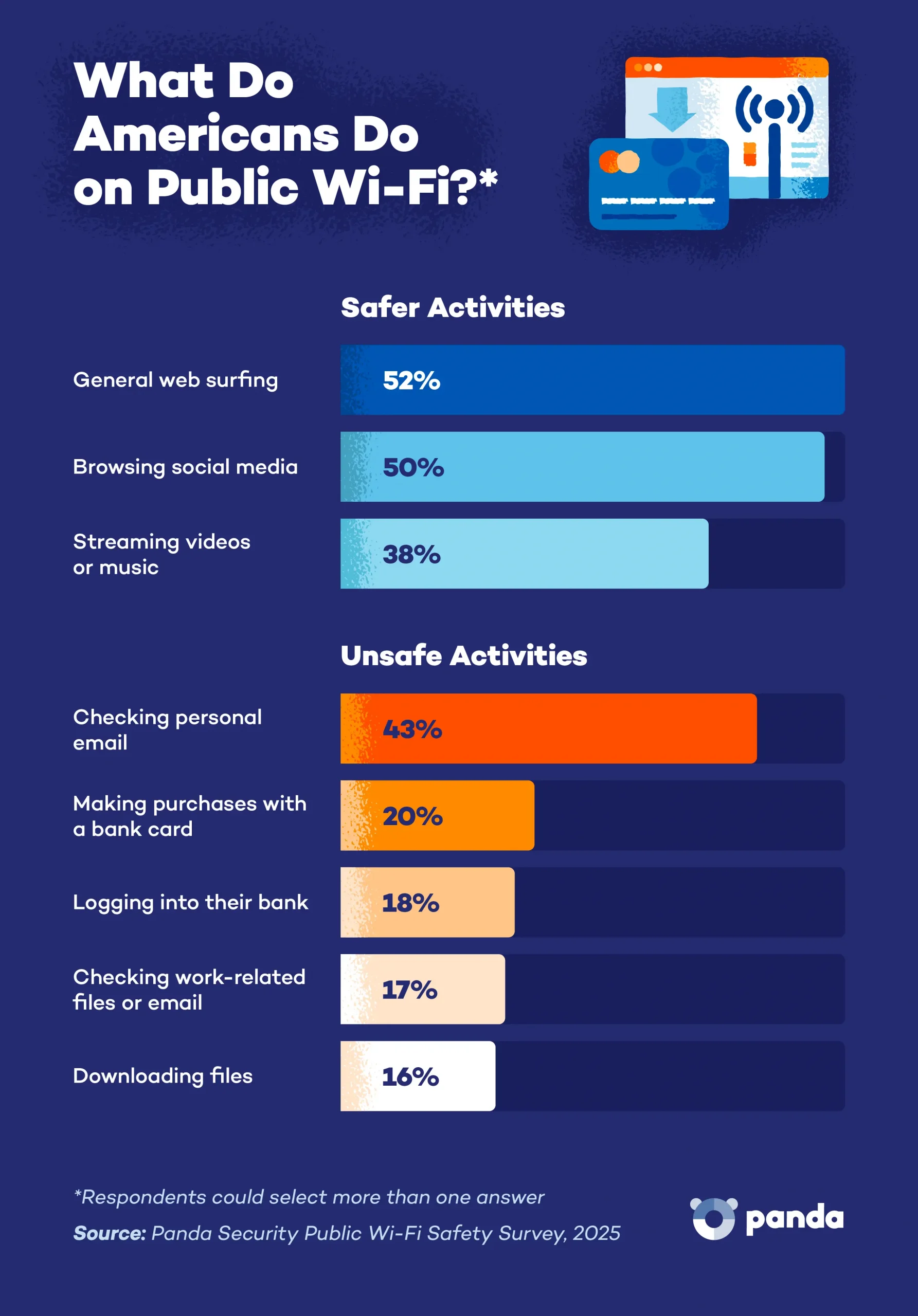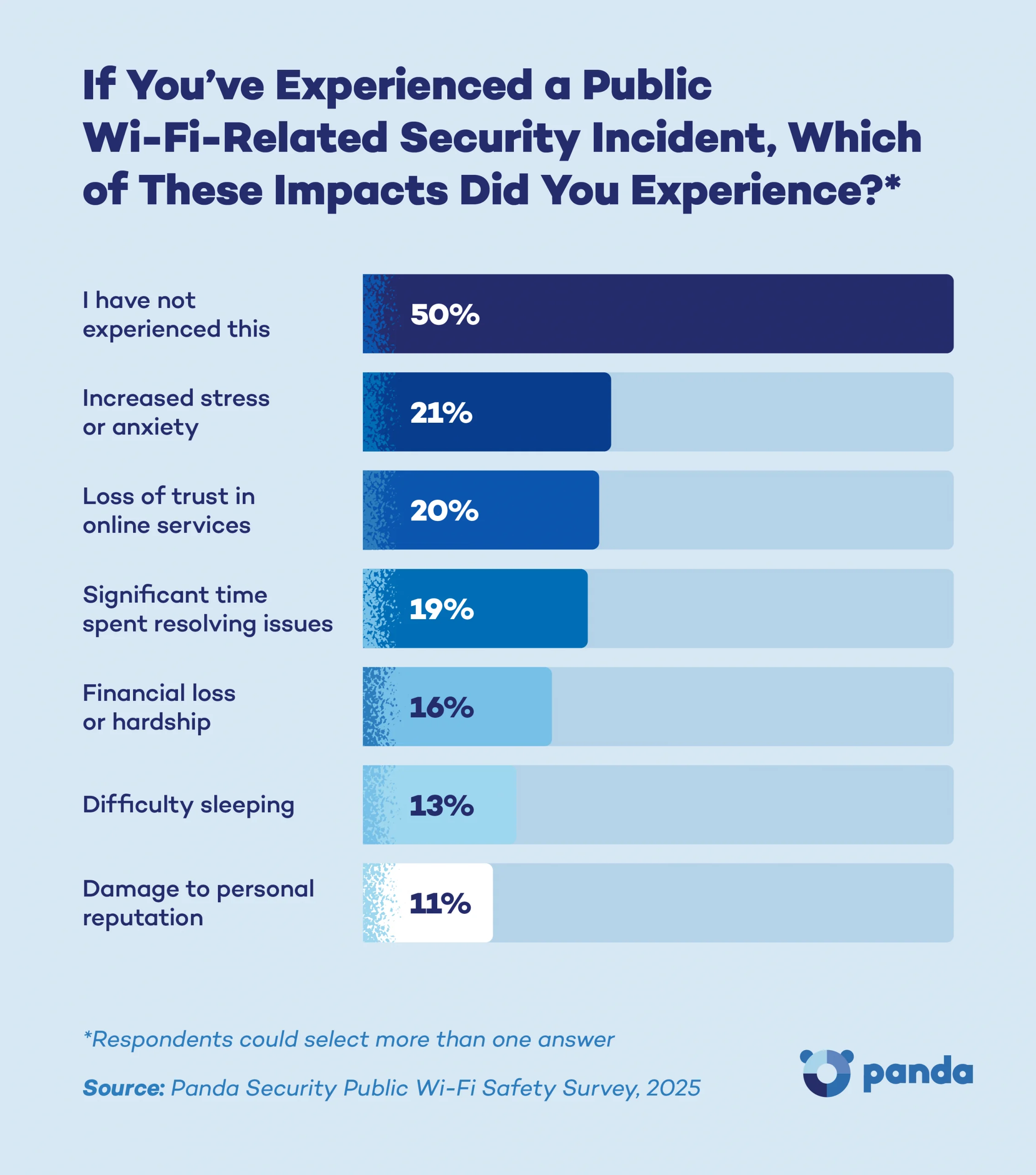You’ve probably had a time where public Wi-Fi has felt like a lifesaver, whether it was downloading a movie to watch on a long train ride or taking a last-minute meeting at your favorite coffee shop. But that convenience doesn’t come without risk.
We surveyed 1,000 Americans in July of 2025 about their public Wi-Fi use, revealing a troubling disconnect between Americans’ stated concerns about public Wi-Fi security and their actual online behavior. Although 66.5% of users express concern about public Wi-Fi safety, nearly one in four (23.5%) Americans forgo basic protective measures like VPNs or antivirus software when connecting to these networks.
So many Americans worry about public Wi-Fi security — but why do risky behaviors persist?
Below, we’ll walk you through what we found and what it reveals about how we should view public Wi-Fi safety.
Key takeaways:
- Over one-third of users (35.3%) say they only use public Wi-Fi for “non-sensitive activities,” yet large numbers report making purchases, logging into bank accounts, and other risky behaviors.
- Women are less confident in their ability to spot malicious Wi-Fi networks than men — yet they experience 42% fewer confirmed or suspected public Wi-Fi security breaches.
- Only one in five Americans (20.2%) are “very confident” they could identify false Wi-Fi networks.
- 11% of Americans who had a security breach after using public Wi-Fi report damages to their reputation.
Nearly 40% of Americans Report Security Incidents After Using Public Wi-Fi

If you’re thinking these high numbers come from people not knowing there’s a risk to using free Wi-Fi, then think again. Over 65% of respondents are moderately to very concerned about public Wi-Fi security, so there may be another factor at play.
Over 1 in 3 Americans Claim to Not Browse Sensitive Data on Public Wi-Fi, Yet Many Admit to Unsafe Searching

Some common risky behaviors include:
- Checking personal email – 43%
- Making purchases with a debit or credit card – 20%
- Logging into their bank – 18%
- Checking work-related files or email – 17%
- Downloading files – 16%
If you’re guilty of some of these, there’s no need to panic. But there are very real security risks that come with these online activities. Malicious public Wi-Fi hot spots can allow users to monitor your screen and even keyboard activity. This can give scammers access to your personal information, work information, financial information, or full access to your device in more extreme cases.
With only 20% of Americans reporting feeling “very confident” in their ability to identify false Wi-Fi networks, using protective tools can help you maintain safer browsing practices, regardless of your familiarity with the latest security threats.
Nearly 1 in 4 Americans Skip Key Protection Even While Handling Sensitive Data on Public Wi-Fi

In particular, users said they skip using a VPN because of the expense, relying on a device’s built-in protection, and forgetting to turn it on. An additional 18% of users also cited that they found a VPN too complicated to set up or use.
Contrary to this belief, there are many free and low-cost VPN options like Panda Dome VPN that are easy to set up in just a few steps. Typically, you just need to download your preferred VPN service and create an account to get started, although setup from different providers may vary.
Women Feel 72% Less Knowledgeable about Public Wi-Fi Risks — Yet They Report 42% Fewer Security Issues

Women report:
- Less confidence in their ability to identify malicious Wi-Fi networks
- A higher likelihood to partake in “unsafe” practices on public Wi-Fi
- Lower likelihood to use third-party security solutions.
Yet, they also report fewer security incidents after using public Wi-Fi.
It’s hard to say the reason why women seem to have fewer security issues without further study but it was also discovered that women reported using public Wi-Fi networks less, with 14% of women accessing a public network multiple times a day compared to 22% of men.
Over 10% of Americans Experienced Damage to Their Reputation After a Public Wi-Fi Security Incident

As scammers take advantage of the AI boom, there are more resources they can use against their victims. Between advances in voice cloning and deepfake technology, it’s become easier to impersonate users. These convincing video or audio clones have become much more realistic — making it easier for scammers to fool your friends, family, and even workplace.
The best way to protect yourself against generative AI scams and traditional vulnerabilities is to protect your devices and data as much as possible. Limit browsing activities with sensitive data to when you’re connected to a secure, password-protected network and use preventative measures like a VPN when in public.
Enjoy Worry-Free Scrolling with Panda Security
There doesn’t have to be such a large gap between Americans’ public Wi-Fi anxieties and their lack of safe browsing habits. Modern security solutions can provide easy protection and peace of mind without keeping you from connecting to friends and family online.
Whether you’re a frequent traveler, remote worker, or simply someone who values their digital privacy, comprehensive protection like Panda Dome can be as automatic as connecting to Wi-Fi itself.
Methodology
The survey of 1,014 U.S. adults 18+ was conducted via SurveyMonkey Audience for Panda Security in July 2025. Data is unweighted and the margin of error is approximately +/-3% for the overall sample with a 95% confidence level. Respondents were allowed to select multiple responses for certain questions, so some responses may add up to over 100%.






